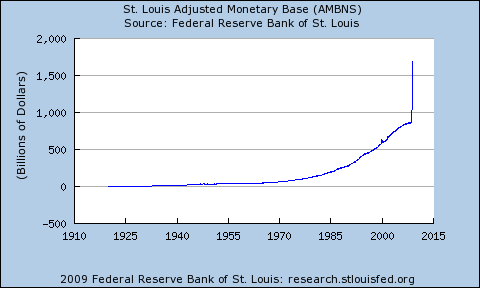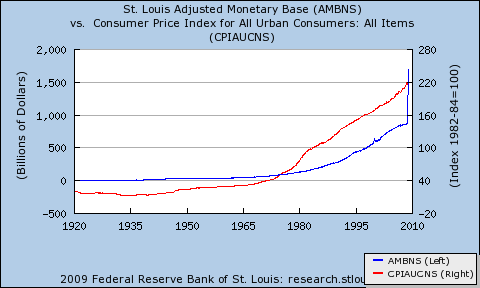« January 23, 2009 | Main | January 27, 2009 »
Sunday, January 25, 2009
Gnome-o-gram: "A new, unprecedented era in financial history"
A “new era”—that's what they always say just before something terrible happens and everybody wakes up and realises they're living in the same old eternal era, but disabused of a mass delusion which has just been popped by the persistent pin of reality. The following is a chart of the Adjusted Monetary Base of the United States, compiled by the Federal Reserve Bank of St. Louis, from the start of 1920 through the start of December 2008. That little blip you see around 2000 is the “Y2K liquidity flood” which some saw, at the time, as a dire departure from the historical trend. But as you can see, it's been “onward and upward” from there…until the last few months when the curve goes vertical, thanks to “bailouts” and “stimulus packages”—and that's not counting the trillions still yet to be enacted. In the space of a few months, the monetary base of the United States has essentially doubled its entire growth since the creation of the Federal Reserve System in 1913.
Whenever you see a vertical line on a financial chart, it's an indication that something extraordinary is happening. Such events almost always end badly. Growth in the monetary base has historically been strongly correlated with inflation as measured by the Consumer Price Index (CPI).
That little blip you see around 2000 is the “Y2K liquidity flood” which some saw, at the time, as a dire departure from the historical trend. But as you can see, it's been “onward and upward” from there…until the last few months when the curve goes vertical, thanks to “bailouts” and “stimulus packages”—and that's not counting the trillions still yet to be enacted. In the space of a few months, the monetary base of the United States has essentially doubled its entire growth since the creation of the Federal Reserve System in 1913.
Whenever you see a vertical line on a financial chart, it's an indication that something extraordinary is happening. Such events almost always end badly. Growth in the monetary base has historically been strongly correlated with inflation as measured by the Consumer Price Index (CPI).
 CPI inflation tends to lag growth in the monetary base, as it takes a while for the newly created money to “work its way through the python” and emerge as price increases. Also, in a deflationary environment, money creation may have no immediate inflationary effect, but when the pendulum swings back the other way, all of that new money will still be in the system, bidding up prices. So, the question is this: if the money creation by the Fed since its inception has caused the purchasing power of the dollar to depreciate by about 95% between 1913 and 2008, then what will an almost instantaneous spike almost equal in magnitude to that of the preceding 95 years do in the near future?
CPI inflation tends to lag growth in the monetary base, as it takes a while for the newly created money to “work its way through the python” and emerge as price increases. Also, in a deflationary environment, money creation may have no immediate inflationary effect, but when the pendulum swings back the other way, all of that new money will still be in the system, bidding up prices. So, the question is this: if the money creation by the Fed since its inception has caused the purchasing power of the dollar to depreciate by about 95% between 1913 and 2008, then what will an almost instantaneous spike almost equal in magnitude to that of the preceding 95 years do in the near future?